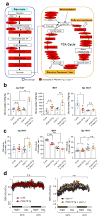UCP1-independent signaling involving SERCA2b-mediated calcium cycling regulates beige fat thermogenesis and systemic glucose homeostasis
- PMID: 29131158
- PMCID: PMC5727902
- DOI: 10.1038/nm.4429
UCP1-independent signaling involving SERCA2b-mediated calcium cycling regulates beige fat thermogenesis and systemic glucose homeostasis
Abstract
Uncoupling protein 1 (UCP1) plays a central role in nonshivering thermogenesis in brown fat; however, its role in beige fat remains unclear. Here we report a robust UCP1-independent thermogenic mechanism in beige fat that involves enhanced ATP-dependent Ca2+ cycling by sarco/endoplasmic reticulum Ca2+-ATPase 2b (SERCA2b) and ryanodine receptor 2 (RyR2). Inhibition of SERCA2b impairs UCP1-independent beige fat thermogenesis in humans and mice as well as in pigs, a species that lacks a functional UCP1 protein. Conversely, enhanced Ca2+ cycling by activation of α1- and/or β3-adrenergic receptors or the SERCA2b-RyR2 pathway stimulates UCP1-independent thermogenesis in beige adipocytes. In the absence of UCP1, beige fat dynamically expends glucose through enhanced glycolysis, tricarboxylic acid metabolism and pyruvate dehydrogenase activity for ATP-dependent thermogenesis through the SERCA2b pathway; beige fat thereby functions as a 'glucose sink' and improves glucose tolerance independently of body weight loss. Our study uncovers a noncanonical thermogenic mechanism through which beige fat controls whole-body energy homeostasis via Ca2+ cycling.
Conflict of interest statement
The authors declare no competitive financial interests.
Figures






Comment in
-
Adipose tissue: Noncanonical beige fat thermogenesis.Nat Rev Endocrinol. 2018 Jan;14(1):2. doi: 10.1038/nrendo.2017.158. Epub 2017 Nov 24. Nat Rev Endocrinol. 2018. PMID: 29170539 No abstract available.
-
Fattening the role of Ca2+ cycling in adaptive thermogenesis.Nat Med. 2017 Dec 7;23(12):1403-1404. doi: 10.1038/nm.4457. Nat Med. 2017. PMID: 29216033 No abstract available.
-
SERCA2b Cycles Its Way to UCP1-Independent Thermogenesis in Beige Fat.Cell Metab. 2018 Jan 9;27(1):7-9. doi: 10.1016/j.cmet.2017.12.015. Cell Metab. 2018. PMID: 29320712
References
-
- Golozoubova V, et al. Only UCP1 can mediate adaptive nonshivering thermogenesis in the cold. FASEB J. 2001;15:2048–2050. - PubMed
-
- Nedergaard J, et al. UCP1: the only protein able to mediate adaptive non-shivering thermogenesis and metabolic inefficiency. Biochimica et biophysica acta. 2001;1504:82–106. - PubMed
-
- Shabalina IG, et al. UCP1 in brite/beige adipose tissue mitochondria is functionally thermogenic. Cell reports. 2013;5:1196–1203. - PubMed
MeSH terms
Substances
Grants and funding
LinkOut - more resources
Full Text Sources
Other Literature Sources
Molecular Biology Databases
Research Materials
Miscellaneous

